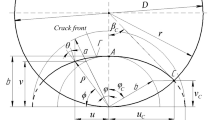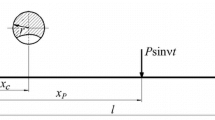Abstract
The xylophone is a percussion instrument made of vibrating wooden bars, the free ends of which can be struck by a mallet. The cross section of xylophone bars is not uniform for tuning purposes. The aim of this study is to impart a better understanding of the frequency shift phenomenon in acoustic resonance of xylophone bars during their tuning operation. A new analytic approach is, therefore, proposed based on the presence of one or several defects (weak elements) in a bar considered as a one-dimensional system in free–free longitudinal and transversal vibration. A weak element mechanically represents one or several real structural irregularities in the wood; this element corresponds to a mechanical behaviour analogy. This weak element is physically characterized by two positional parameters and by its Young’s modulus. Dynamic tests and numerical computations by the finite elements method give results in good accordance with those of the weak element method. It is shown that when the element weakens, the natural frequencies decrease. Furthermore, the frequency shift depends on the weak element position along the bar. It is also reported that longitudinal and transverse dynamic behaviours are similar regarding the presence of a weak element in a bar.















Similar content being viewed by others
References
Aramaki M, Brancheriau L, Baillères H, Guillemain P, Kronland R, Lanvin JD (2000) Modeling vibration response of wooden beams with singularities using sound synthesis model. 12th International symposium on nondestructive testing of wood, University of Western Hungary, Sopron, pp 113–121
Bernoulli D (1748) Réflexion et Eclaircissement sur les Nouvelles Vibrations des Cordes Exposées dans les Mémoires de l’Académie. Royal Academy of Berlin, Berlin 1750 pp
Bordonné PA (1989) Module Dynamique et Frottement Intérieur dans le Bois, Mesures sur Poutres Flottantes en Vibrations Naturelles. PhD thesis, Institut National Polytechnique de Lorraine 109 pp
Bork I (1983) Zur Abstimmung und Kopplung von schwingenden Stäben und Hohlraumresonatoren. PhD thesis, Dissertation. Tech Univ Carolo-Wilhelmina, Braunschweig
Brancheriau L (2002) Expertise mécanique des sciages par analyses des vibrations dans le domaine acoustique. PhD thesis, Université de la méditerranée-Aix Marseille II. Ecole supérieure de mécanique de Marseille 267pp
Brancheriau L, Bailleres H (2002) Natural vibration analysis of clear wooden beams: a theoretical review. Wood Sci Tech J 36:347–365
Chaigne A, Doutaut V (1997) Numerical simulation of xylophones. I. Time-domain modelling of the vibrating bars. J Acoust Soc Am 101(1):539–557
Doutaut V, Matignon D, Chaigne A (1998) Numerical simulations of xylophones. II. Time-domain modelling of the resonator and of the radiated sound pressure. J Acoust Soc Am 103(3):1633–1647
Fletcher NH, Rossing TD (1991) The physics of musical instruments. Springer Verlag, New York pp 533–554
Love AEH (1892) A treatise on the mathematical theory of elasticity (edition of 1944). Dover Publications, New York, pp 643
Rayleigh JWS (1877) The theory of sound (edition of 1945). Dover Publications, New York 243–305 pp
Timoshenko S (1921) On the correction for shear of the differential equation for transverse vibrations of prismatic bars. Philos Mag J Sci XLI(6th series):744–746
Wawrzynek J (1989) VLSI models for sound synthesis. In: Mathews MV, Pierce JR (eds) Current directions in computer music research. Mit Press Series in System Development Foundation Benchmark, pp 113–148
Author information
Authors and Affiliations
Corresponding author
Rights and permissions
About this article
Cite this article
Brancheriau, L., Baillères, H. & Sales, C. Acoustic resonance of xylophone bars: experimental and analytic approaches of frequency shift phenomenon during the tuning operation of xylophone bars. Wood Sci Technol 40, 94–106 (2006). https://doi.org/10.1007/s00226-005-0011-3
Received:
Published:
Issue Date:
DOI: https://doi.org/10.1007/s00226-005-0011-3




